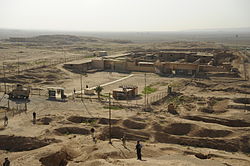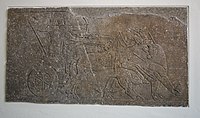Νιμρούντ
Συντεταγμένες: 36°5′53″N 43°19′44″E / 36.09806°N 43.32889°E
| Νιμρούντ | |
|---|---|
 | |
| 36°5′53″N 43°19′44″E | |
| Χώρα | Ιράκ και Ασσυρία |
| Διοικητική υπαγωγή | Ντουχόκ |
Η αρχαία Ασσυριακή πόλη Νιμρούντ (στα αραβικά: النمرود) βρίσκεται περίπου 30 χιλιόμετρα νότιοανατολικά της Μοσούλης, στο βόρειο Ιράκ.
Πιστεύεται ότι η σημερινή ονομασία δόθηκε στην πόλη στη σύγχρονη εποχή και ότι προέρχεται από το όνομα του μυθικού ήρωα Νιμρόντ (Nimrod).[1][2] Σύμφωνα με τον Χένρι Ρώλινσον πρόκειται για τη βιβλική πόλη Χαλάχ (Calah).[3][4]
Τον Μάρτιο του 2015 σε βίντεο που δόθηκε στη δημοσιότητα από το Ισλαμικό Κράτος φαίνονται μέλη του να καταστρέφουν με μπουλντόζες τα ερείπια της πόλης. Τον Απρίλιο του 2015 η αρχαία πόλη Νιμρούντ ανατινάχθηκε από τους Τζιχαντιστές σύμφωνα με το βίντεο που δόθηκε στη δημοσιότητα από το Ισλαμικό Κράτος.
Φωτογραφίες από ευρήματα από τις ανασκαφές στην Νιμρούντ τα οποία βρίσκονται σε διάφορα μουσεία σε ολόκληρο τον κόσμο[Επεξεργασία | επεξεργασία κώδικα]
-
Ασουρνασιρπάλ Β΄ -Μουσείο του Λούβρου
-
Κυνήγι λιονταριού -Μουσείο Περγάμου
-
Πόλη υπό πολιορκία -Βρετανικό Μουσείο
-
Μάχη Ιππικού -Βρετανικό Μουσείο
Παραπομπές[Επεξεργασία | επεξεργασία κώδικα]
- ↑ Genesis 10:11-12, Micah 5:5, and 1Chronicles 1:10
- ↑ Brill's Encyclopedia of Islam 1913-36, p.923, "Nimrud": "At the present day the site is known only as Nimrud, which so far as I know first appears in Niebuhr (1778, p. 355, 368). When this, now the usual, name arose is unknown; I consider it to be of modern origin. It should be noted that names like Nimrod, Tell Nimrod, etc. are not found in the geographical nomenclature of Mesopotamia and the Iraq in the middle ages, while they are several times met with at the present day."
- ↑ Journal of the Royal Asiatic Society, Volume 12, page 417, quote "The title by which it is designated on the bricks and slabs that form its buildings, I read doubtfully as Levekh, and I suspect this to be the original form of the name which appears as Calah in Genesis, and Halah in Kings and Chronicles..."
- ↑ The Conquest of Assyria, Mogens Trolle Larsen, 2014, Routledge, page 217, quote: "Rawlinson explained to his audience that the large Assyrian ruin mounds could now be given their proper names: Nimrud was Calah..."
Βιβλιογραφία[Επεξεργασία | επεξεργασία κώδικα]
- Henry C. Rawlinson, On the Birs Nimrud, or the Great Temple of Borsippa, The Journal of the Royal Asiatic Society of Great Britain and Ireland, τομ. 18, σελ. 1–34, 1861
- D. J. Wiseman, The Nabu Temple Texts from Nimrud, Journal of Near Eastern Studies, τομ. 27, ν. 3, σελ. 248–250, 1968
- D. J. Wiseman, Fragments of Historical Texts from Nimrud, Iraq, τομ. 26, ν. 2, σελ. 118–124, 1964
- Barbara Parker, Seals and Seal Impressions from the Nimrud Excavations, Iraq, τομ. 24, ν. 1, σελ. 26–40 1962
- Barbara Parker, Nimrud Tablets, 1956: Economic and Legal Texts from the Nabu Temple, Iraq, τομ. 19, ν. 2, σελ. 125–138, 1957
Εξωτερικοί σύνδεσμοι[Επεξεργασία | επεξεργασία κώδικα]
|
| Αυτό το λήμμα χρειάζεται επέκταση. Μπορείτε να βοηθήσετε την Βικιπαίδεια επεκτείνοντάς το. |






